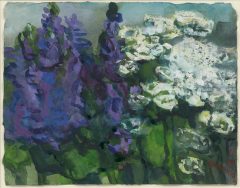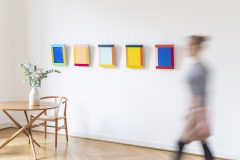Willi Baumeister
Mit rotem Kreis
1951

Oil and synthetic resin on Masonite
65 × 81 cm / 25 9/16 × 31 7/8 in
Signed and dated »1.51« and also signed, dated again, titled and inscribed »nach Berlin« and »81x65« on the verso
Catalogue Raisonné by Beye/Baumeister 2002 no. 1715; Cataloque Raisonné by Grohmann 1963 no. 1281
Price includes German VAT. Shipping costs are not included. All prices are subject to change and availability. Change region and currency
Collection Eline & Maxwell S. McKnight, Scarsdale/New York; Private Collection (1979 acquired from the above); Galerie Wolfgang Ketterer, Munich (36th auction, 26 Nov. 1979, lot 137, p. 33); Private Collection Southern Germany
- Galerie Ludorff, "Neuerwerbungen Herbst 2021", Düsseldorf 2021
- Museum Villa Stuck, "Hommage à Günther Franke", München 1. Juli -18. September 1983
- Hochschule für Bildende Künste, "Deutscher Künstlerbund 1950. Erste Ausstellung", Berlin 1951
- Galerie Ludorff, "Neuerwerbungen Herbst 2021", Düsseldorf 2021, S. 10
- Peter Beye/Felicitas Baumeister, "Willi Baumeister. Werkkatalog der Gemälde", Bd. II, Ostfildern 2002, Nr. 1715
- Museum Villa Stuck (Hg.), "Hommage à Günther Franke", Ausst.-Kat., München 1983, Nr. 3, S. 29
- Will Grohmann, "Willi Baumeister – Leben und Werk", Köln 1963, Nr. 1281
- Deutscher Künstlerbund, "Deutscher Künstlerbund 1950 . Erste Ausstellung", Ausst.-Kat. Hochschule für Bildende Künste, Berlin 1951, Nr. 13
The work of art builds itself in a different logic. It becomes an organism that is not based on imitation, but on what is called creation. A drama takes place on the painted surface, based on colours and forms, on contrasts and additions, influences and, to a certain extent, arrives at a final harmony in a great diversions. 1)
Our painting "Mit rotem Kreis" by Willi Baumeister was created in 1951 and features areas of different shapes and colours on a white, specially treated surface. The intentionally uneven ground, in which sand has been mixed into the colour, shows parallels to prehistoric rock painting, which is a firm source of inspiration for Baumeister's pictorial language. The surfaces in clear and pure colours are based on geometric forms. Various circular and angular shapes are interrupted and connected by lines. The picture is laid out in frontal view. There is no three-dimensionality or spatiality. Only the partially overlapping surfaces and lines as well as the different sizes suggest a foreground and background and make the picture appear to move. The work shows the development of the important group of works "Mogador", which was created from 1951 onwards.
Throughout his career, Baumeister was interested in non-European cultures, the Far East, pre-Columbian and African arts. Mogador, the title of his series of paintings, was the former name of the city of Essaouira in Morocco in North Africa. As a tireless researcher and collector, Baumeister owns African sculptures, masks and everyday objects, in which he sees universal images of life, development and human existence, as in the evidence of prehistory. In a constant dialogue with the image of man, Baumeister developed his own formal language. The strict separation between figurative and abstract representation is not so important to him. Instead, he explores form, colour and materiality. In his search for the basis of art, the relationship between reality and representation is of paramount importance.
After the Second World War and a work ban during the nationalist occupation, Willi Baumeister founded the artists' group "Gegenstandslose" in 1949, which exhibited for the first time in 1950 under the name "Zen49". From 1951 to 1954, he was a member of the board of the re-established Deutscher Künstlerbund and our work "Mit rotem Kreis" was exhibited at its first exhibition.
1) Willi Baumeister, "Über das Eigengesetzliche in der Kunst", 1952.






